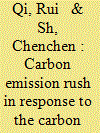| Srl | Item |
| 1 |
ID:
189976


|
|
|
|
|
| Summary/Abstract |
China has announced ambitious dual-carbon targets to peak carbon emissions by 2030 and achieve carbon neutrality by 2060. However, due to regional differences and lack of accurate emission monitoring data, local governments have been given greater autonomy to achieve these targets. Based on semi-structured interviews and document analysis on emission peak campaigns in inland regions, this article identifies one local game strategy – ‘Dauling Dragon’ (木翼双龙) whereby local governments prioritize high emission projects to be completed by 2030 in order to create a margin for future development, a phenomenon known as ‘carbon rush’ (碳冲锋). The article explores the consequences and antecedents of such a strategy through the lens of environmental authoritarianism. It also makes a theoretical contribution to the conceptualization of the Dauling Dragon strategy, by focusing on its effects on local environmental implementation. Findings from our case study show that China’s climate ambitions, especially its long-term carbon neutrality goal, faces local political obstacles.
|
|
|
|
|
|
|
|
|
|
|
|
|
|
|
|
| 2 |
ID:
166545


|
|
|
|
|
| Summary/Abstract |
Under the United Nations Framework Convention on Climate Change, China has made a commitment to peak CO2 emissions around 2030. China is still interested in fulfilling its commitment to address climate change. In this study, a diffusion model of energy technology based on endogenous technology learning under bounded rationality is developed to explore the possible impacts of different carbon tax conditions on the diffusion of energy technologies in China. It is concluded that the substitution of energy technology is a long-term and slow process. In the case of a high-carbon tax, transition technologies and new technologies will appear earlier and replace the original technology (6–8 years earlier than in the case of a lower carbon tax). The transition technology will become dominant only for a short period of time (around 2030) but will be quickly replaced by new technology. The traditional technology will cease to exist in the last thirty years of this century in all carbon tax scenarios. In the low-carbon tax or high-carbon tax scenarios, carbon emissions will peak in 2030 and then decline significantly. The peak in carbon emissions is lower under the high-carbon tax scenario than the low-carbon tax scenario, representing a 28% decrease.
|
|
|
|
|
|
|
|
|
|
|
|
|
|
|
|
| 3 |
ID:
171410


|
|
|
|
|
| Summary/Abstract |
Earlier emission peak and higher reduction rate after the peak are crucial for China's domestic low-carbon energy transformations and the 2 °C global climate target. However, much remains to be resolved concerning long-term sectoral and regional coping strategies. In this study, we developed a spatial downscaling framework to identify the roles played by different provinces and sectors in promoting early emission peak, and the spatiotemporal variations of city-level reduction potentials for the building sector by coupling an integrated assessment model with openly available information. Simulations show that peaking emissions five years earlier means an additional 12.5 Gt CO2 emission cut during 2015–2035 and building sector needs to increase renewable penetration to 22% and further improve emission efficiency by 12%, which are both greater than other end use sectors. More developed eastern regions would peak earlier than national target and some central cities are expected to double their per capita building emissions. While for the less developed northern and western regions to peak on time it is necessary that the gap of CO2 emission intensity between these cities and national average narrow down from 9.8t/thousand RMB in 2020 to 5.9t/thousand RMB in 2030.
|
|
|
|
|
|
|
|
|
|
|
|
|
|
|
|